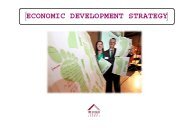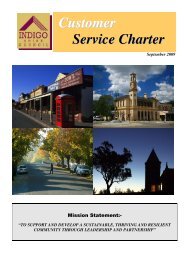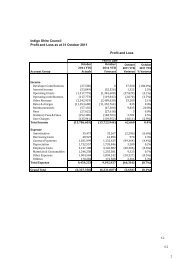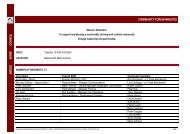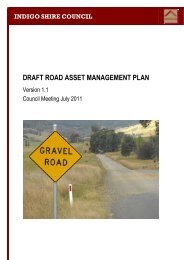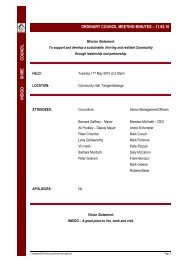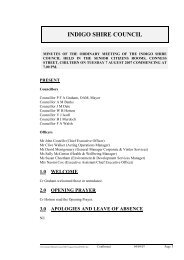Indigo Shire - renewable energy mapping - Indigo Shire Council
Indigo Shire - renewable energy mapping - Indigo Shire Council
Indigo Shire - renewable energy mapping - Indigo Shire Council
You also want an ePaper? Increase the reach of your titles
YUMPU automatically turns print PDFs into web optimized ePapers that Google loves.
Earth Systems<br />
Mapping and Brokering Local Energy Solutions in <strong>Indigo</strong> <strong>Shire</strong><br />
economic equation in the short to medium term. The <strong>Shire</strong> should carefully watch the space and develop<br />
a strategy to capitalise on the opportunity for large-scale solar when the economics improve. In the<br />
meantime, generation of less than 100 kW e in Victoria is currently eligible for a FIT of 8 c/kWh. (<strong>Indigo</strong><br />
<strong>Shire</strong> may consider facilitating the installation of a number of 99.9 kW e solar PV systems on suitable roof<br />
areas as an immediate form of local generation.)<br />
Wind: Overall, the resource is marginal, but specific low-speed turbines may be able to capitalise on it.<br />
The economics are expected to be very sensitive to actual wind velocity at these low speeds. Payback<br />
periods are, however, better than solar due to lower capital equipment cost and better capacity factor.<br />
Wind data available may not accurately characterise particularly localised, higher-than-average wind<br />
velocity resources peculiar to specific land topography within the <strong>Shire</strong>, and local knowledge should be<br />
evaluated. The <strong>Shire</strong> should also consider engagement opportunities with other regions in which wind<br />
resources are more significant.<br />
Biomass: At present, about 3.4 MW e of generation is possible from the recovery of absolutely all<br />
available waste biomass in the entire <strong>Shire</strong> (including agricultural wastes). Energy crops, waste from<br />
forest fuel reduction, and/or a significant import of biomass from outside the <strong>Shire</strong> would be needed to<br />
provide a significant bio<strong>energy</strong> contribution. Significant (but currently fully utilised) plantation waste<br />
resources exist just beyond <strong>Shire</strong> boundaries, equating to a maximum power generation of about 8.3<br />
MW e . To generate the whole-of-<strong>Shire</strong> target of 13 MW e , an area of approximately 16,100 Ha would be<br />
required under an appropriate solid block short rotation coppice cropping (SCC) scheme. Under an intercropping<br />
SCC scenario this extends to 132,400 Ha. Depending on the scenarios, bio<strong>energy</strong> plant<br />
economic modelling at the small, medium and large generating capacity had LCOEs of 185, 118 and 110<br />
$/MWh e including electricity and thermal heat sales. Possible co-generation opportunities exist at a<br />
number of sites within the region, including Uncle Toby’s and Murray Goulburn, provided their existing<br />
waste resources could be augmented by additional biomass. These, and several other sites are to be<br />
addressed in further detail in Phase 2 of the project.<br />
Geothermal: No significant geothermal resource is indicated in <strong>Indigo</strong> <strong>Shire</strong>. The existing data is limited,<br />
so the finding should be re-visited in the event that a new dataset for the region is developed.<br />
Hydropower: Large-scale hydro in and near to the <strong>Shire</strong> appears to have been fully exploited. Some<br />
small-scale (e.g. < 1 MW e ) resources exist in the <strong>Shire</strong>, however they are mostly associated with areas of<br />
cultural significance. There may be justification for individual small-scale projects, but these lie outside<br />
the scope of this Study.<br />
Suggested Priorities for Decision Making<br />
Reviewing the variety of resource potentials, generation costs and grid constraints presented in the<br />
preceding sections, it is possible to make some general observations on how a total generation output of<br />
13 MW e may be accomplished within the <strong>Indigo</strong> <strong>Shire</strong> region.<br />
<br />
<br />
<br />
<br />
<br />
There is little economy of scale benefit in going larger within the range of generation considered,<br />
other than for bio<strong>energy</strong> plant. Therefore, generation scale is likely to be dictated by network<br />
capacity (i.e. largest generator that can be connected without major network infrastructure costs).<br />
There are significant economic benefits in generation resulting in avoided retail power purchase.<br />
There are significant economic benefits in co-generation (possibly even tri-generation) at a given<br />
site.<br />
There may be additional incentives for installing site generation if it avoids the need for the<br />
network operator to undertake other infrastructure upgrades.<br />
Although the resource is marginal, the LCOE of wind means it is an attractive option..<br />
ISC1240_Phase_1_Report_Rev0_public report 142




